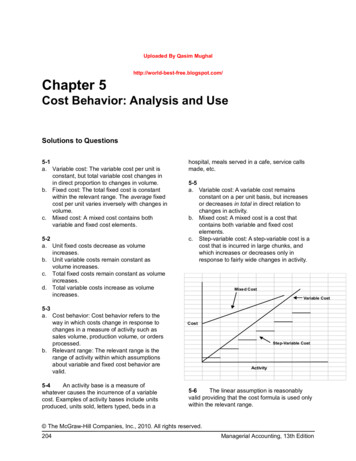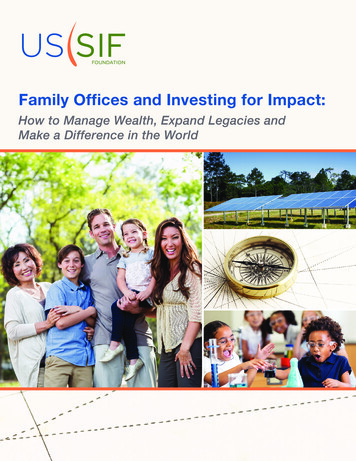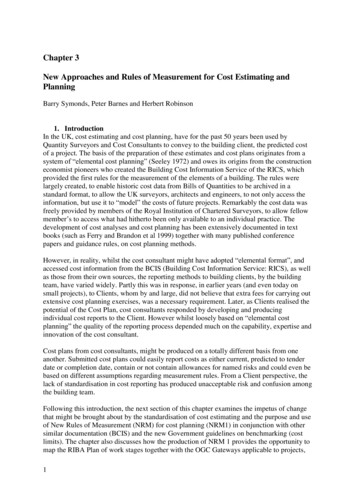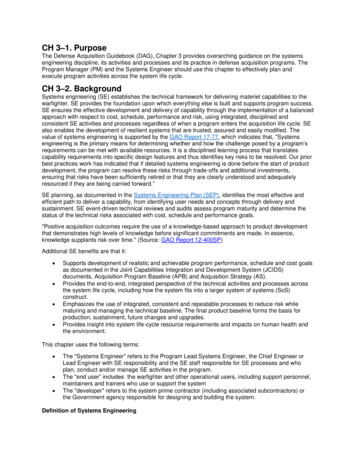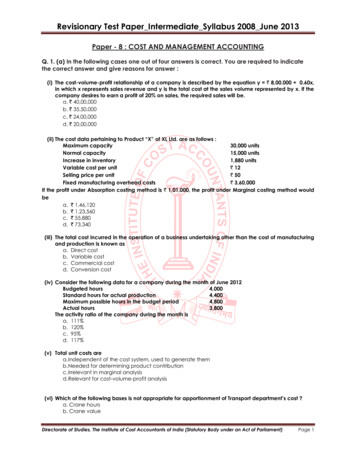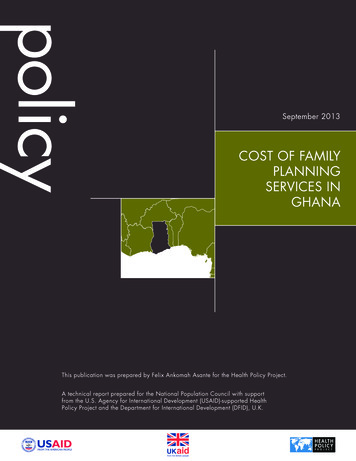
Transcription
September 2013COST OF FAMILYPLANNINGSERVICES INGHANAThis publication was prepared by Felix Ankomah Asante for the Health Policy Project.A technical report prepared for the National Population Council with supportfrom the U.S. Agency for International Development (USAID)-supported HealthPolicy Project and the Department for International Development (DFID), U.K.H E A LT HPOLICYP R O J E C T
Suggested citation: Asante, F. A. 2013. Cost of Family Planning Services in Ghana. Washington, DC: FuturesGroup, Health Policy Project.ISBN: 978-1-59560-104-9The Health Policy Project is a five-year cooperative agreement funded by the U.S. Agency for InternationalDevelopment under Agreement No. AID-OAA-A-10-00067, beginning September 30, 2010. It is implementedby Futures Group, in collaboration with Plan International USA, Avenir Health (formerly Futures Institute),Partners in Population and Development, Africa Regional Office (PPD ARO), Population Reference Bureau(PRB), RTI International, and the White Ribbon Alliance for Safe Motherhood (WRA).
Cost of Family Planning Services inGhanaSEPTEMBER 2013This publication was prepared by Felix Ankomah Asante for the Health Policy Project.A Technical Report Prepared for the National Population Council with Support from the U.S. Agency forInternational Development (USAID)-supported Health Policy Project and the Department for InternationalDevelopment (DFID), U.K.The information provided in this document is not official U.S. Government information and does notnecessarily represent the views or positions of the U.S. Agency for International Development or the U.KDepartment for International Development.
TABLE OF CONTENTSTable of Contents .iiiList of Tables . vList of Figures . vAbbreviations . viExecutive Summary .viiiMethodology . viiiResults . viiiBackground . 1Introduction . 1Family Planning in Ghana . 1Study Objectives . 5Family Planning Service Interventions Costed . 6Target Audiences for the Study . 7Scope of the Study . 8Timeframe and Analytic Horizon. 8Methodology . 8Costing Approach . 8Study Sites . 8Types of Inputs Costed . 12Data Collection and Analysis. 12Limitations of the Study. 13Results . 14Unit Cost of Family Planning Services . 14Indirect and Direct Costs . 15Components of Direct Cost . 15Projected Cost of Family Planning Services in Ghana, 2012–2016 . 16Total Cost . 16Components of Direct Cost . 16Conclusion . 26References . 27Appendix 1: Details of How the Costs were Estimated . 28Appendix 2: Questionnaire—Estimating the Unit Cost of Delivering Family Planning Services . 31Costs per Facility: Hospital . 31Costs per Facility: Health Centres and Community Health Practitioners . 32Costs per Facility: Health Centres and Community Health Practitioners . 33iii
Costs per Facility: Polyclinics . 34Costs per Facility: Maternity Home . 35iv
LIST OF TABLESTable 1: Number of Users of Family Planning Service Methods, 2010–2012 . 3Table 2: Site Selection for Cost of Family Planning Services . 10Table 3: Unit Cost of Family Planning Services in Ghana . 14Table 4: Projected Total Cost of Family Planning Services in Ghana, 2012–2016 (US ) . 18Table 5: Projected Direct Cost of Family Planning Services in Ghana, 2012–2016 (US ). 21LIST OF FIGURESFigure 1: Trend in Family Planning Method Preference, 2010–2012. 4Figure 2: Direct and Indirect Cost of Family Planning Services . 15Figure 3: Components of Direct Cost of Family Planning Services (Percentage) . 16v
ABBREVIATIONSAIDSacquired immune deficiency syndromeCHPSCommunity-Based Health Planning ServicesCICcombined injectable contraceptiveCOCcombined oral contraceptiveCPRcontraceptive prevalence rateDMPADepot Metroxyprogesterone AcetateFHUfamily health unitFPfamily planningGDHSGhana Demographic and Health SurveyGHSGhana Health ServiceGSSGhana Statistical ServiceHIVhuman immunodeficiency virusHPPHealth Policy ProjectIUDintrauterine deviceLAMlactational amenorrhoea methodMDGsMillennium Development GoalsNET-ENNorethisterone EnanthateNFPnatural family planningNGOsnongovernmental organisationsNHIANational Health Insurance AuthorityNHISNational Health Insurance SchemeNPCNational Population CouncilPOIprogestin-only injectablePOPprogestin-only pillsSTIsexually transmitted infectionTFRtotal fertility ratevi
UNFPAUnited Nations Population FundUSAIDUnited States Agency for International DevelopmentVSCvoluntary surgical contraceptionvii
EXECUTIVE SUMMARYFamily planning (FP) is a major component of reproductive health, one of the pillars of safe motherhood,and an entry point to other reproductive health services such as prevention and management of sexuallytransmitted infections (STIs) and HIV and AIDS, comprehensive abortion care, management of infertility,screening for reproductive tract cancers, and prevention of gender-based violence (GHS, 2007). In 2012,the government of Ghana included FP commodities and services in the benefit package of the NationalHealth Insurance Scheme (NHIS), creating a need to assess the cost of family planning. This activityfocused on costing the FP services included in the National Family Planning Protocols of 2007, which arecurrently being delivered in health facilities and by nongovernmental organisations (NGOs) in Ghana.The objectives of the study were to determine the unit cost (direct and indirect) of providing FP servicesin Ghana and to project the resource requirements for scaling up FP services from 2012 to 2016.MethodologyThe study was carried out between March and July 2013. A bottom-up ingredients approach to costing, inwhich all inputs were listed and their contribution to the overall cost tallied, was combined with a stepdown approach to allocate direct and indirect costs to each FP service on the basis of utilisation orworkload. Nineteen purposefully selected sites were studied: five hospitals, two polyclinics, three healthcentres, three Community-based Health Planning Services (CHPS), two maternity homes, and four NGOservice points. The sites reflect the key characteristics thought to influence unit cost estimation, includingthe level of health facility; location within the country; and ownership and utilisation of FP services. Thestudy used 2012 service statistics in the 19 selected sites and 2012 prices to value the inputs’ economiccost.ResultsThe study found that on average the cost per client per year for the provision of FP services ranged from135.29 Ghanaian cedi (GH ) (US 75.16) and GH 82.60 (US 45.89) for female condoms and combinedinjectable contraceptive (CIC) to GH 11.75 (US 6.53) and GH 11.25 (US 6.25) for natural familyplanning (NFP) and lactational amenorrhoea method (LAM), respectively. The unit cost for other FPservices were as follows: male condoms, GH 20.43 (US 11.35); combined oral contraceptive (COC),GH 26.87 (US 14.93); progestin-only or mini-pills (POP), GH 19.46 (US 10.81); progestin-onlyinjectable (POI), GH 45.72 (US 25.40); implants, GH 63.11 (US 35.06); intrauterine devices (IUDs),GH 19.39 (US 10.77); tubal ligation, GH 52.20 (US 29.00); and vasectomy, GH 46.36 (US 25.76).Projecting the cost of providing all FP services in the country shows a rise from US 40,480,136.02 in2014 to US 43,634,330.54 in 2015 and US 46,922,214.96 in 2016, an increase of 15.91 percent between2014 and 2016. The cost of FP commodities is expected to grow from US 8,074,816 in 2014 toUS 8,628,121 in 2015 and US 9,204,240 in 2016, representing an increase of 13.99 percent between2014 and 2016.viii
BACKGROUNDIntroductionFamily planning (FP) plays a pivotal role in the attainment of many of the Millennium DevelopmentGoals (MDGs) in Ghana. It is a major component of reproductive health, one of the pillars of safemotherhood, and an entry point for other reproductive health services such as prevention and managementof sexually transmitted infections (STIs) and HIV and AIDS, comprehensive abortion care, managementof infertility and gender-based violence cases, and screening for reproductive tract cancers (GHS, 2007).In Ghana, the National Family Planning Protocols of 2007 provide standard guidance for FP serviceprovision at all levels and for both the public and private sectors, including nongovernmentalorganisations (NGOs).Recognizing the link between rapid population growth and social and economic development, thegovernment of Ghana has worked to build a positive policy environment for family planning, an effortspearheaded by the National Population Council (NPC). Article 3, clause 4 of the 1992 Fourth RepublicanConstitution of Ghana enjoins the government to maintain a population policy that is consistent with theaspirations and development needs of the country. The NPC was established in 1992 and given legalbacking by the 1994 National Population Council Act 485. It is responsible for coordinating allpopulation-related programmes in the country, setting targets for programme performance, interpretingand reviewing the population policies, undertaking and commissioning research to inform policy making,and ensuring the integration of population variables into development planning in Ghana.In 2011, the NPC and its partners initiated a process to cost FP commodities and services in Ghana insupport of its advocacy and coordination of FP programme implementation. The aim of this exercise wasto assist the council in making a case for the inclusion of FP commodities and services in the benefitspackage of the National Health Insurance Scheme (NHIS). The government subsequently madepronouncements to do so (NHIA Act 852 of 2012); there is a need to assess the cost of FP commoditiesand services and combine these cost data with demographic data and coverage goals to generate theresources required for scaling up family planning nationally.Family Planning in GhanaGhana’s Population Policy of 1969 was one of the first on the African continent. However, a 1989assessment by the national Population Policy Technical Advisory Committee documented the lack ofprogress in achieving the goals the policy had set out, as a result of a lack of grassroots involvement in thedevelopment of the policy and a strategic plan for implementation. In 1994, the policy was revised to takethese factors into account. The National Population Policy (Revised Edition, 1994) set clear targetsregarding fertility and contraceptive use and addressed emerging issues such as HIV and AIDS,population and the environment, concerns about the elderly and children, and the development of newstrategies to ensure achievement of the revised policy objectives. The revision also entailed a concertedeffort to systematically integrate population variables into all areas of development planning.1
Cost of Family Planning Services in GhanaSelected Major Goals of the Revised Population Policy (NPC, 1994) To reduce the total fertility rate (TFR) from 5.5 in 1993 to 5.0 by year 2000, 4.0 by 2010, and 3.0 by2020. Accordingly, the policy aims to achieve a contraceptive prevalence rate (CPR) of 15percent for use of modern methods by year 2000, 28 percent by 2010, and 50 percent by 2020. To make family planning services available, accessible and affordable to at least half of all adultsby the year 2020. To reduce the proportion of women below 20 years and above 34 years having births to 50percent by the year 2010 and to 80 percent by 2020. To reduce the population growth rate from 3 percent to 1.5 percent by 2020 while increasing lifeexpectancy from the current level of 58 years to 65 years by 2010, and 70 years by 2020.The attainment of these population goals is recognised as an integral component of the national strategy toaccelerate economic development, eradicate poverty, and enhance the quality of life for all Ghanaians.These policies are further supported by the current national blueprint for development, the Ghana SharedGrowth and Development Agenda (2010–2013), which recognizes family planning as a top priority forinclusion in national development plans and activities at all levels.In collaboration with the United Nations Population Fund (UNFPA), the United States Agency forInternational Development (USAID), the World Bank, and other development partners, Ghana hasimplemented several family planning and reproductive health projects. Support from these agencies hastargeted policy coordination, implementation, and service delivery.Since the revised policy was implemented in 1994, improvements in family planning have accelerated.Data from the 1993 to 2008 Ghana Demographic and Health Surveys (GDHS) showed a decrease in thecountry’s TFR—to an average of four children per woman in 2008—and a CPR increase for modernmethods to 19 percent in 2003, followed by a decline to 17 percent in 2008. Although the TFR hasdeclined and contraceptive prevalence has increased, unmet need for family planning among marriedwomen remained high (50% in 1988 and 42% in 2008) and women continue to have more children thanthey desire.The Ghana Health Services/Family Health Unit (FHU) has made the availability and appropriate use ofFP services a priority. Data from the five consecutive GDHS (1988–2008) showed marked increases inknowledge about family planning and use of FP services and methods available in Ghana. Between 1993and 1996, the FHU expanded access to permanent (mini-laparotomy and vasectomy) and long-acting(IUDs and implants) methods and introduced the monthly (combined) injectable and female condom inboth the public and private sectors.Current use of contraception varies by residence (urban or rural, and regional) and levels of education andwealth. The 2008 GDHS showed that women in urban areas were more likely to use modern methods ofcontraception than women in rural areas (24.2% vs. 14.9%). Use of both male and female condoms,IUDs, and female sterilisation is two to three times higher in urban areas than in rural Ghana. Theprevalence of modern method use ranges from 7.7 percent and 9.7 percent in Northern and Upper Eastregions to 24.8 percent and 26.0 percent in Brong Ahafo and Greater Accra regions, respectively.The order of preferred methods has changed since the 1998 GDHS. The proportion of non-users whoprefer injectables for future use increased from 36 percent in 1998 to 43 percent in 2003, and declined to39 percent in 2008. The proportion of non-users who prefer pills decreased from 21 percent in 1998 to 15percent in 2003, and increased to 21 percent in 2008. Preference for implants increased from 4 percent in2
Background1998 to 11 percent in 2003, and remained steady for five years (10% in 2008). Intention to use the IUDalso increased from 2 percent in 1998 to 4 percent in 2003, and declined to 1 percent in 2008. In 1998, 4percent of non-users said that they preferred to use female sterilisation in the future compared with just 2percent in 2008.Short-term contraceptive methods include oral contraceptive pills, condoms, and injectables. Long-termcontraceptive methods provided include IUDs, female sterilisation, vasectomy, implants, and naturalmethods. A total of 2,084,686 individuals used some FP service methods in 2010 while 2011 and 2012recorded 1,699,128 and 1,548,293 users, respectively (Table 1).Table 1: Number of Users of Family Planning Service Methods, 2010–2012Number of UsersFamily Planning --Combined pill (COC)240,286153,940161,041Mini pill (POP)25,99630,53630,067Norigynon inject (CIC)124,368186,28284,229Depo injectable ,6861,699,1281,548,293Fertility awareness-based methodsBarrier methodsMale condomFemale condomSpermicide (foaming tablet)Hormonal MethodsReversible FP methodsIUDPermanent FP methodsVasectomyTubal ligationTotal usersSource: Ghana Health Service, 2010–2012 Annual Reproductive and Child Health Reports, Accra, Ghana.Injectables accounted for the highest use in all three years, increasing proportionally from 41 percent in2010 to 50 percent in 2011 and 56 percent in 2012. This is followed by condom use, which formed about39 percent of total use in 2010, but declined to 27 percent in 2011 and 17 percent in 2012. The pill (boththe combined oral contraceptive and mini pill) ranked third in all three years, accounting for 12 percent oftotal use on average. The use of LAM has increased from 3 percent in 2010 to 6 percent in 2011 and 7percent in 2012. In 2010, there was some use of spermicidal foaming (contraceptive) tablets (0.03% oftotal use) but none in 2011 or 2012. Long-term contraceptive methods such as IUDs and vasectomy alsoreceived minimal patronage. NFP methods, apart from LAM, accounted for less than 1 percent of total3
Cost of Family Planning Services in Ghanause in all three years. Figure 1 shows the national shifts in short- and long-term methods between 2010and 2012.Figure 1: Trend in Family Planning Method Preference, blesSterilisationLAMNFPCondomsPillsSource: Ghana Health Service, 2010–2012 Annual Reproductive and Child Health Reports, Accra, Ghana.4
BackgroundAs shown on Figure 1, more women are choosing long-term methods, and the government will need toensure the availability of commodities and trained personnel to meet this increased demand (GSS et al.,2008). As the government takes over a greater share of responsibility for financing FP programmes withdomestic resources, it requires up-to-date information about the cost of FP services. Such information willfeed into future strategic planning and coordination and resource mobilisation for family planning,whether integrated into the NHIS or otherwise.Study ObjectivesThe objectives of the FP costing study are primarily to provide the GHS/FHU in the Ministry of Health,as well as other programs into which family planning is integrated, a better understanding of the costs ofdelivering FP services. The specific objectives of the costing study are to Calculate unit cost estimates for a range of FP service delivery methods and commodities Identify the cost drivers (direct and indirect) of the specific unit costs for each FP service deliverymodality Provide estimates of FP costs from 2014 to 2016The study results provide information on unit costs of delivering FP services through a variety ofmethods, at different levels of the healthcare system and in different locations throughout the country.Additional analyses should be able to use this data to assess the most efficient ways of delivering FPservices, and to identify the best allocation of resources to minimise costs of the FP component of NHIS.5
FAMILY PLANNING SERVICE INTERVENTIONS COSTEDThe FP services costed in this study are provided at all levels by the public or private sector, includingNGOs. In all, 12 service delivery methods in the 2007 National Family Planning Protocols were includedin the study.Fertility Awareness–based Methods1.1. Natural FamilyPlanning (NFP)NFP can be used to either avoid or achieve pregnancy. The service can be providedseparately or as a part of an established health and family planning or communityagency programme. Delivery of NFP services is not dependent on medicallyqualified personnel. The NFP methods used include basal body temperature (BBT),calendar (rhythm), and symptothermal.1.2. LactationalAmenorrhoea(LAM)LAM is a short-term contraceptive method which can be initiated at the moment ofbirth or early in the postpartum period and used for up to six months if the motherremains amenorrhoeic and practices exclusive breastfeeding. Suckling at the breastcauses suppression of ovulation.Barrier Methods1.3. Condoms (maleand female)Condoms are thin sheaths made of latex rubber, vinyl, or polyurethane, which maybe treated with spermicides for added protection against pregnancy and sexuallytransmitted diseases such as HIV. There are two types of condoms: the male condomand the female condom. Worn by the man, a male condom is a thin covering madeof latex, plastic, or animal membrane to prevent sperm from entering a woman’sbody. Worn by the woman, the female condom is a tube of soft plastic(polyurethane) that helps keep sperm from getting into her body.1.4. Diaphragm orCervical CapEach of these barrier methods is placed inside the vagina to cover the cervix toblock sperm. The diaphragm is a dome-shaped (rubber) shallow cup. The cervicalcap is a thimble-shaped (soft rubber) deep cup with a firm, round rim. It fits aroundthe base of the cervix. They are inserted into the vagina with spermicide beforesexual intercourse to block or kill sperm.1.5. SpermicidesSpermicides are chemicals that deactivate or kill sperm cells and provide lubricationand additional barrier effect. They come in several forms: gel, foam, tablet, cream,suppository, or film. Spermicides can be used alone or in combination with acondom, diaphragm, or cervical cap.Reversible Hormonal Methods1.6. Combined OralContraceptive(COC)COC, also called “the pill,” consists of a course of 21 synthetic hormone pills(oestrogen and progestin, similar to hormones naturally present in a woman’s body)and seven iron pills per cycle.1.7. Progestin-Only Pill(POP)POP, also called “the mini pill” contains only one hormone (progestin) instead ofboth oestrogen and progestin. POP is a good choice for breastfeeding women whowant to use oral contraceptives or those who cannot take oestrogen. It is not a goodoption for women who have breast cancer or liver disease, or tuberculosis patientson Rifampicin.1.8. CombinedInjectableContraceptive(CIC)CIC, or “the shot,” is a combination of natural oestrogen and progestin administeredat four-week intervals by deep intramuscular injection in a woman’s buttocks or arm.The formulation currently available in Ghana is Norigyon.6
Family Planning Service Interventions Costed1.9. Progestin-OnlyInjectable (POI)POI, or “the mini shot,” contains only the hormone progestin that is administered viainjection in a woman’s buttocks or arm. There are two preparations currentlyavailable in Ghana: depot medroxyprogesterone acetate (DMPA), or Depo Provera;and norethisterone enanthate (NET-EN), or Noristerat. A single injection of DMPA orNET-EN provides safe and highly effective contraception for three or two months,respectively.1.10. ImplantImplant is a single, thin, flexible rod (capsule) that is inserted under the skin of awoman’s upper arm. The rod contains progestin (Levonorgestrel) that is released intothe body over three years. There are two types of implants in Ghana: Jadelle,consisting of two small plastic capsules, and Norplant, consisting of six small plasticcapsules.Reversible Non-Hormonal Methods1.11. IntrauterineDevices (IUDs)The IUD is a small, flexible T-shaped plastic device that is inserted into a woman’suterine cavity. It releases a small amount of progestin each day to preventpregnancy. An applicator is used to insert and remove the IUD through the openingof the cervical canal. The most commonly used IUDs in FP programmes in Ghana arethe copper-bearing CUT 380 IUD (effective for up to 10–12 years) and Multiload(MLCu250 and 375) and the NOVAT (both effective for up to 5 years).Permanent Methods1.12. Voluntary SurgicalContraception(VSC)VSC is a minor surgical procedure—vasectomy for men and tubal ligation forwomen—to prevent the patient from having any more children. Male sterilisation: A vasectomy keeps a man’s sperm from going to his penis, sohis ejaculation never has any sperm that can fertilize an egg. Female sterilization: Tubal ligation (or “tying tubes”) and transcervical sterilisationprevent the sperm and eggs from meeting for fertilization. The woman can haveher fallopian tubes tied (or closed) or a tiny device threaded into each fallopiantube.TARGET AUDIENCES FOR THE STUDYMany stakeholders in Ghana have an interest in the cost of FP services. The target audiences for thisstudy are1. The government of Ghana, including the NPC, GHS, Ministry of Health, Ministry of Finance,and the National Health Insurance Authority (NHIA)2. International donor and technical assistance agencies3. Civil society organisations in Ghana that provide FP services and for advocate family planning7
SCOPE OF THE STUDYThe FP costing exercise built on previous work undertaken by the NPC and its partners. It used acombination of normative approaches listed in the 2007 Family Planning Protocols and collection of datafrom a number of health facilities in each of the three ecological zones of Ghana: coastal, forest, andsavannah.The sampling was based on the magnitude of utilisation of FP services (high, medium, low) andownership (government, mission, private, NGO). Selection of the health facilities took into considerationthe structure of health delivery systems in Ghana (teaching hospitals, regional hospitals, district hospitals,polyclinics, health centres, CHPS). The data collection was based on service statistics for 2012 to ensurecomplete statistics in all facilities.TIMEFRAME AND ANALYTIC HORIZONFor any study, the timeframe (period over which the service is carried out) and analytic horizon (pe
Health Insurance Scheme (NHIS) , creating a need to assess the cost of family planning. This activity focused on costing the FP services included in the National Family Planning Protocols of 2007, which are currently being delivered in health facilit


